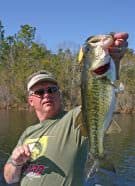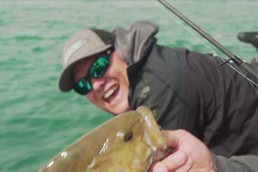Point Attack on Spring Bass
SHARE THIS POST
Running and gunning points with crankbaits is sure to catch you some bass on nearly any body of water in the springtime. That is about as safe a claim as any I could ever make. In fact, crankin’ points is bound to catch you more than just bass in a typical Wisconsin or Minnesota water that features so many different species. Throw a crankbait over a wave-pounded point on any lake or flowage in the North Country and you’re apt to tangle with bass, pike, walleyes and maybe even a mighty muskie. You simply never know what you’re going to catch off a point.
Now that I have your full attention on the importance of points, let’s take a closer look at how to find the best points on any given body of water. I have a ridiculously simple formula that works for me no matter where I fish, no matter how big or small the lake, river or reservoir is. Honestly, I’ve used this same simple point attack on waters from Canada to Florida. In a nutshell, points are points. While fish are likely to be attracted to points more on one body of water versus another, the plain fact is that points in general are nearly always worth a cast or two no matter where you fish.
First off, let’s establish what I precisely mean by the term “point.” Any projection in the shoreline landmass that extends outward into the water, breaking up an otherwise relatively straight shoreline contour, is technically a point. Points can be diverse; some are very small and subtle while others are large and very pronounced. Rarely are large points unproductive. They always attract fish of all kinds and are often one of the most popular spots on a lake. Small points, however, are often overlooked. While some small points are bound to be duds, some of the best points I’ve ever fished are these smaller ones.
When bass are on what many of us like to call a “point bite,” which happens throughout early spring and then again in the fall, I suggest eliminating all other locational factors from your game plan initially until you’ve spent some time “runnin’ and gunnin” all the good-looking points within easy range. On a small lake in Wisconsin there might be less than 10 land points available on the whole body of water. Yet, on a larger flowage or reservoir, there could be as many as 100 or more.
For simplicity sake, let’s examine the small lake with only 10 points total. Before the actual spring spawn, when water temperatures are still below the 60-degree mark, I generally only fish the points that have wave action pounding into them. With that in mind, I will immediately eliminate at least half of these points if no wave action is hitting them. So, if that small lake containing 10 points only has five with wind/wave action, I will initially focus all of my efforts on those five points alone. After fishing all five, I might find that only two or three are worth a second effort. I might also find a small subtle point or two near a major producer that is also active.
Are you enjoying this post?
You can be among the first to get the latest info on where to go, what to use and how to use it!
The next day out, a shift in wind might turn on several other points that I ignored previously. Keeping an eye out for wind shifts is important. An active point for days might suddenly shut off with a wind switch. A point that looked good, but was out of the main wind/wave action, could suddenly turn on with a new wind direction. The only way to know for sure is to attack the point with cranks.
How I attack a point with crankbaits depends somewhat on the terrain and the depth of the bottom around the point, but for the most part, one simply can’t go wrong initially by throwing a shallow-lipped floating diver. There are so many good versions out there, but I’ll admit that I do have a few favorites such as the old original Storm Wiggle Wart or a Bagley Kill’R B. But there are a host of others out there that are sure to work. The main is to choose a floating diver with a squared lip that fends off snags while traveling over various cover. Color-wise, it’s tough to beat a brownish-orange crawdad-style pattern at this time of year since bass in particular are sure to be feeding on them a lot.
If the point contains too much trashy cover such as weed growth or some other vegetation, a spinnerbait might be a better option. However, if the point has low growing grass, or better yet, rocks and gravel with a mix of sunken wood, a crankbait is tough to beat. As a follow up, I will often turn 180 degrees after finishing up on a point with one bait, and then attack it with another. The initial approach might have featured more perpendicular casts with a shallow-lipped diver, but this reverse angle attack centers on long arching parallel casts with a deeper diver to reach spots that were a tad out of range for the shallow runner. A sinking lipless crankbait is a big favorite here since I can literally cast it out, let it sink to the bottom and then hop-and-drop it all the way back to the boat—I usually catch some of my biggest bass with this tactic.
While points aren’t the only place holding bass and other gamefish on any given lake in the spring, they are always a good place to start. It’s a good bet that if you follow the simple point attack I’ve outlined here, you’re bound to bag a few big ones on any water you fish this spring.
MWO
SHARE THIS POST
Did you enjoy this post?
You can be among the first to get the latest info on where to go, what to use and how to use it!
Joe Bucher
Joe Bucher is a Freshwater Fishing Hall of Fame Legendary Angler, book author, lure designer and host of Fishing with Joe Bucher TV series.



